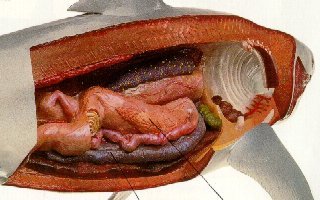
Main Page Content Page Next Page
| Packaged neatly inside spinner shark’s body are all the organs that keep it alive. To breathe, sharks have gills which absorb oxygen from the water and release carbon dioxide back into it. These gases are transported to and from the gills by the blood. The heart pumps the blood around the body, delivering oxygen and nutrients while taking away carbon dioxide and other wastes. To get energy for all their activities, including growth and repair, sharks need to eat. Food passes into the digestive system, which is like a large tube. From the mouth the food goes down the gullet into the stomach, where digestion begins, and then into the intestine where digested food is absorbed. Indigestible wastes collect in the rectum to be passed out of the body. Digested food is further processed in the large liver which also increases the shark’s buoyancy. Kidneys remove wastes from the blood and regulated blood concentration. Large muscles in the body wall keep the shark swimming while the skeleton and skin provide support. The brain co-ordinates the shark’s actions with signals or instructions passed back and forth along the spinal cord. Finally, sharks like all animals cannot live forever and must reproduce to carry on the species. Female sharks produce eggs from their ovaries and males sperm from their testes. When sperm meets egg, a new life begins. |
 |